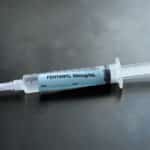Fentanyl is responsible for a significant number of overdose deaths in the United States. Illicit fentanyl is often used to counterfeit a wide variety of other substances including oxycodone, hydrocodone, and heroin.
Those who use fentanyl, whether with a legitimate prescription or through improper drug abuse, can rapidly become physically or mentally dependent on the drug. Once this occurs, any attempt to stop taking fentanyl is likely to trigger a variety of uncomfortable withdrawal symptoms.
Fentanyl Withdrawal Timeline
Fentanyl withdrawal symptoms, a form of opioid withdrawal syndrome, may begin as quickly as six hours after your last dose.
However, symptoms may arise more slowly if you’ve taken an extended-release version of the medication, including a fentanyl patch, or more quickly in cases of severe fentanyl addiction.
Because fentanyl is a short-acting opioid drug, symptoms tend to be intense but short-lived, and are described as being flu-like.
An approximate fentanyl withdrawal timeline includes:
6-12 Hours After Last Dose
Early symptoms of withdrawal begin and may include insomnia, agitation, and persistent yawning.
12-24 Hours After Last Dose
Withdrawal symptoms continue building into physical effects like sweating, headache, runny nose, muscle aches, bone pain, spasms, difficulty sleeping, and loss of appetite.
Individuals may also experience psychological effects including drug cravings, anxiety, aggression, and restlessness.
1-4 Days After Last Dose
Withdrawal symptoms intensify and peak, with additional symptoms including diarrhea, nausea, vomiting, hypertension/high blood pressure, goosebumps, increased heart rate, exhaustion, and stomach cramps.
Your thinking, memory, and mental performance may also be impacted.
5-7 Days After Last Dose
After peaking, withdrawal symptoms may begin to ease, ultimately fading around one week after your last dose.
Post-Acute Withdrawal Syndrome (PAWS)
Post-acute withdrawal syndrome (PAWS) is a potential complication of opioid or opiate withdrawal that involves certain persistent symptoms that may occur for several weeks or even months after acute withdrawal symptoms have concluded.
Symptoms of PAWS generally center on feelings of unwellness and certain lingering mental health effects, potentially including:
- depression
- concentration problems
- lack of energy
- disturbed sleep
- difficulty feeling pleasure from natural sources (anhedonia)
While PAWS can be a frustrating and drawn-out consequence of opioid dependence, it is temporary and will likely pass with time.
Potential Risks Of Fentanyl Withdrawal
Fentanyl withdrawal is rarely life-threatening. However, seizures and critical dehydration from vomiting and poor hydration have led to medical emergencies and fatalities.
In addition, those who attempt to quit fentanyl cold-turkey without medical supervision are at an increased risk of relapse, due to the severity of both the mental and physical effects of fentanyl withdrawal.
Relapses during the withdrawal process can be extremely dangerous due to changes in tolerance and the risk of a fentanyl overdose.
For these reasons it is strongly recommended that anyone considering withdrawing from fentanyl do so through a formal medical detox program, which provides close medical support, security, and assistance for the length of the withdrawal process.
Fentanyl Addiction Treatment
Fentanyl and opioid addiction are treated with a variety of different methods, including medical detoxification, medication-assisted treatment, and comprehensive inpatient or outpatient treatment services.
Medical Detox Programs
Due to the potential severity of fentanyl withdrawal symptoms, medical professionals generally advise a detoxification program that provides medical supervision and support in a healthcare setting.
If symptoms are severe, medical staff can provide medications to alleviate discomfort, as well as consult with the patient’s physician about tapering options. Tapering reduces fentanyl doses over time rather than quitting cold turkey.
Medication-Assisted Treatment (MAT)
In this treatment, specialized long-acting prescription opioids are prescribed to activate a person’s opioid receptors and prevent withdrawal symptoms, without triggering a euphoric high.
A mixture of buprenorphine and naloxone, sold under the brand name Suboxone, is one option. Clonidine, methadone, and naltrexone may also be available.
Unlike other MAT medications, naltrexone is not an opioid agonist. Rather, it is a long-lasting opioid antagonist, meaning that it blocks opioid receptors as well as the euphoric and sedative effects of opioid drug use.
While results vary, evidence supports the conclusion that MAT is an effective treatment for opioid dependence.
Inpatient/Outpatient Treatment
Inpatient treatment involves living at a treatment center for a set duration of time, while outpatient services allow you to commute back and forth to a rehab center.
With a personalized treatment plan that may include MAT, behavioral therapy, and peer support groups, both treatment options can be effective for people living with substance use disorder.
To learn about our outpatient substance abuse treatment options, please contact us today.
Sources
Written by
Northeast Addition Editorial Team
©2024 Northeast Addition Center | All Rights Reserved
This page does not provide medical advice.



